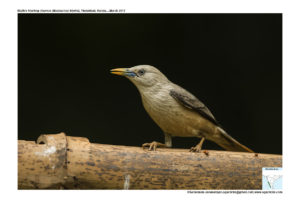
Blyth’s Starling Sturnia (malabarica) blythii
Etymology :
- Sturnia : Latin word for starling
- Malabarica : From Malabar reigon in India
- Blythii : Named after English zoologist Edward Blyth (1810–1873)
Vernacular Names: Mar: Pandhrya Dokyachi Myna
Distribution in India: Resident of Western Ghats and Southern peninsula
Description: Size of 20-21 cm. The male has brilliant white head and breast, grey rump is washed cinnamon; flanks, lower belly and under tail-coverts are rufous, primary coverts are black, bases of primaries are white. The female differs from male in having white restricted to forehead, chin and throat, with crown and nape grey with pale streaking, breast is greyish, merging into creamy rufous on lower belly and flanks, with under tail-coverts greyer, less rufous than male.
Habitat: It is found in Open woodland and areas with scattered trees; often in young forestry plantations, also close to human habitation, lowlands and foothills.
Food Habits: It eat insects like caterpillars, beetles, termites, bees, flies, bugs and earwigs. It also eats seeds & fruit like figs and also nectar. The nestlings fed mainly with insects, particularly caterpillars and beetles. It is highly arboreal, foraging with great agility in fine branches in flowering trees, gleaning insects; forages also in low bushes and occasionally on ground.
Breeding Habits: They breed in Apr–Jul in North India and Feb–May in South India. They are Monogamous. They make a nest of grass, rootlets and twigs, placed by both parents in tree hole, often old hole of Woodpecker or Barbet. They lay a clutch of 3–5 eggs. Both male and female participate in incubation of eggs and feeding of chicks. The incubation period is 12 days. The nestling period is 18–21 days.